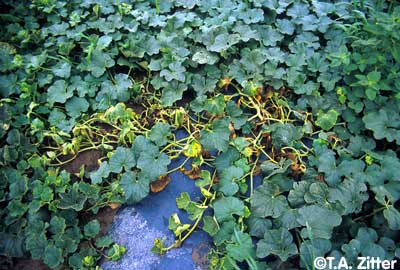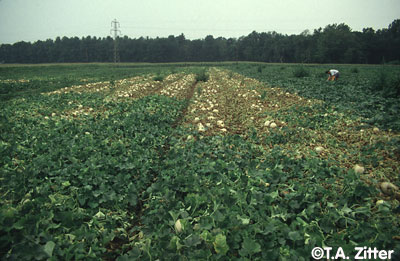
Fusarium root rot of melons
| Primefact number | Edition | Published | Author |
|---|---|---|---|
| 1642 | First | May 2018 | Plant Biosecurity and Product Integrity |


The fungal species Fusarium oxysporum f.sp. melonis, F. oxysporum f.sp. niveum and F. oxysporum f.sp. radicis-cucumerinum that cause root rot in melons are present in Australia. However, there are exotic strains of fusarium wilt overseas that can be more damaging or harder to control than Australian strains. Exotic strains of this disease are a concern for Australia’s melon industry.
There are a number of different strains of fusarium root rot throughout the world. We have some strains already present in Australia, however, different strains generally affect different host plants and so remain a threat to biosecurity. There are also exotic races of the species we already have that have evolved overseas and can be more aggressive or harder to manage with regular control methods.
Notifiable status
Exotic strains of fusarium root rot in melons is not a notifiable plant disease in NSW.
However, if you suspect exotic strains of fusarium root rot in melons:
- Call the Exotic Plant Pest Hotline 1800 084 881
- Email biosecurity@dpi.nsw.gov.au with a clear photo and your contact details
A full list of notifiable plant pests and diseases can be found in Schedule 2 of the NSW Biosecurity Act 2015.
Description
Fusarium root rot, or fusarium wilt, infects the roots of plants at all stages of crop development.
Initially, the lower leaves of plants infected with fusarium root rot show signs of wilt at midday, only to recover during the evening and at night (Figure 1). As the disease progresses, the wilt advances to affect all leaves followed by symptoms of yellowing, leaf death and stunting of mature plants.
In mature plants, the wilt may initially be confined to particular tendrils if only a section of the root system is infected.
Cross sections cut from the roots and lower stems of infected plants show brown discolouration of the inner tissues.
A field infected with fusarium root rot will show patches of affected plants where the fungus occurs and is spreading in the soil (Figure 2). The development of fungal spores can be found on dead stems in wet weather.
Damage
All growth stages are susceptible to fusarium root rot. Infected seedlings often die and older plants are subject to sudden, severe wilting and often plant death before reaching maturity.
In less severe infections plants may survive but become stunted and have reduced yield.
There is no known treatment for fusarium root rot and once established in the soil the fungus is able to survive without a host plant for several years. Fields may become unsuitable for production unless resistant varieties are planted.
Lifecycle
The fusarium fungus grows through the soil until it comes in contact with host plant roots.
Fungal strands (hyphae) enter the roots to obtain nutrients from the plant. Once inside, the fungus continues to grow upwards through the roots and stems. Growth of the fungus inside plant roots and stems blocks the supply of water to the plant.
As the plant dies, the fusarium wilt fungus grows out onto the surface of leaves and stems where it produces fungal spores.
Spores are returned to the soil as diseased plant material decays. Spores can remain dormant in soil for several years before infecting a new host.
Host range
The fusarium strains F. oxysporum f.sp. melonis, F. oxysporum f.sp. niveum and F. oxysporum f.sp. cucumerinum are highly specialised, attacking only a single crop species each:
- Musk melons (including rockmelon and honeydew) are the primary host of F. oxysporum f.sp. melonis
- Watermelon is the primary host of F. oxysporum f.sp. niveum
- Cucumber is the primary host of F. oxysporum f.sp. radicis-cucumerinum
Spread
Fusarium root rot is spread over long distances in contaminated soil. Contaminated soil can be carried on the roots of host plants, boots and clothing, vehicles, machinery and equipment. Fusarium can also be carried in contaminated plant material, or on seeds.
Fusarium root rot spreads locally by growing through the soil from one host plant to another and by spores in the soil. This is a relatively slow process, though fungal dispersal may be aided by on farm activities moving infected soil with people and machinery, or by loose soil being carried in rain runoff.
Distribution
Fusarium root rot is widespread in melon growing regions throughout the world, including Australia.
However, there are more damaging versions of the disease known to occur overseas that we don’t have in Australia; strains that have evolved in isolation that can be more aggressive than established strains.

